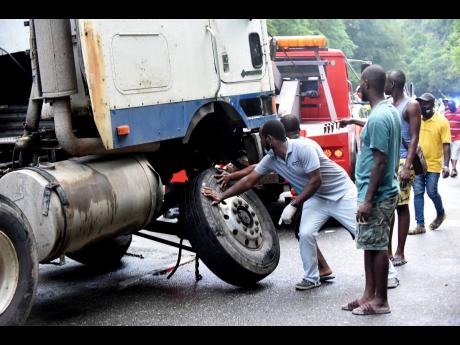Don’t get rid of your tyres too early ... get maximum life first
The tyres on your car lead a very hard life, from flexing hundreds of miles every minute, to rolling over deep potholes, manholes, rough asphalt, concrete, stone and gravel. They also slide on patches of oil, splashing through water, mud and crunching over broken glass, rusty nails and debris of all sizes, shapes and texture. However, motorists should not retire their tyres too early, but care and maintenance should be top priority to obtain maximum life of these tyres.
“First, a tyre is a doughnut formed by layers or plies of reinforced fabric,” says Cleveland ‘Singer B’ Smith, a St Andrew-based tyre repair specialist. The doughnut is the casing, now around that casing is attached firmly a heavy moulded rubber-compound ring called the tread. According to Smith, in a standard bias-ply tyre the reinforcing cords of rayon, nylon or polyester in the fabric layers, run in a criss-cross pattern, at an angle to the centre line of the tyre.
“Car owners should maintain proper air pressure in the tyres on their vehicle,” advised Smith. He explained that under-inflation and over-inflation account for a great deal of problems in tyres. Under-inflation wears down the outer portion of the tread faster than the centre, and also causes excessive flexing of the cord, which generates too much heat. This leads to flex fatigue of the piles and separation of the carcass from the rubber thread.
Over-inflation is hard on suspension, which causes a hard ride and tends to wear down the centre of the tread faster than the outer portion.
In order to get maximum life from your tyres, Cleveland Smith gives a few pointers:
1. Check air pressure on a regular basis. This must be done with a quality pressure gauge. Follow the air pressure recommendations. Check air pressure when your tyres are cold, and before, not after the trip. A cold tyre is one that has not been driven more than three miles for several hours. It is best, therefore, to check the air pressure.
2. Replace a tyre if it has the following physical damage: bulged areas, cuts that extend into the fabric and excessive tread wear. Tread wear that leaves tread depth 1/16 inch or less across two adjacent tread ribs is considered excessive. Measure tread depth by placing a $10 coin in the ribs at different spots. If the top of George William Gordon’s head shows, the tread depth is too shallow.
3. Tyre tread should be inspected at least weekly for cuts or other possible damage. Check each tread rib for embedded stones or other foreign material such as glass, stones, nails, debris. Carefully pry them out with a screwdriver.
4. Remove valve caps and wet valve stems. If you see water bubbles, there is a leak. Replace the valve core. Then inflate the tyre to specified pressure.
5. Replace any tyre valve caps which may have become lost or misplaced. The caps keep water and grit out of the valve and prevent leak-producing damage to the valve stem.
6. Motorists can extend the life of their tyres by rotating them every, say, 9,600 to 12,800 kilometres, to balance tread wear. Rotation should be advised by a competent tyre specialist. For example, radial tyres should be rotated front and rear on the same side of the car. This is because criss-crossing radials can affect their ride and handling characteristics.


